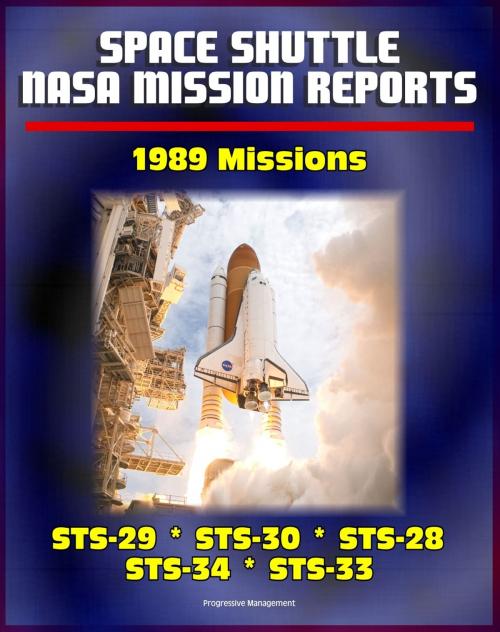Space Shuttle NASA Mission Reports: 1989 Missions, STS-29, STS-30, STS-28, STS-34, STS-33
Nonfiction, Science & Nature, Technology, Aeronautics & Astronautics, Science, Physics, Astrophysics & Space Science| Author: | Progressive Management | ISBN: | 9781466069299 |
| Publisher: | Progressive Management | Publication: | January 5, 2012 |
| Imprint: | Smashwords Edition | Language: | English |
| Author: | Progressive Management |
| ISBN: | 9781466069299 |
| Publisher: | Progressive Management |
| Publication: | January 5, 2012 |
| Imprint: | Smashwords Edition |
| Language: | English |
These official final program mission reports issued by the NASA Johnson Space Center cover missions in 1989: STS-29, STS-30, STS-28, STS-34, and STS-33. In these thorough reports, with information and specifics not available on NASA website mission descriptions, each orbiter system is reviewed in detail along with technical information on performance and anomalies.
STS-29: The primary objective of the STS-29 mission was to successfully deploy the Tracking and Data Relay Satellite-D/Inertial Upper Stage satellite. The crew for this mission was Michael L. Coats, Capt., U. S. Navy, Commander; John E. Blaha, Col., U. S. Air Force, Pilot; Robert C. Springer, Col., U. S. Marine Corps, Mission Specialist 1; James F. Buchli, Col., U. S. Marine Corps, Mission Specialist 2; and James P. Bagian, M.D., Mission Specialist 3.
STS-30: The primary objective of the STS-30 mission was to successfully deploy the Magellan spacecraft. The crew for this mission was David M. Walker, Capt., U. S. Navy, Commander; Ronald J. Grabe, Col., U. S. Air Force, Pilot; Mark C. Lee, Major, U. S. Air Force, Mission Specialist 1; Norman E. Thagard, M.D., Mission Specialist 2, and Mary L. Cleave, Ph.D, Mission Specialist 3.
STS-28: The STS-28 mission was a classified Department of Defense mission. The crew for this thirtieth flight of the Space Shuttle were Brewster H. Shaw, Jr., Col., USAF, Commander; Richard N. Richards, Cdr., USN, Pilot; James C. Adamson, Lt. Col., USA, Mission Specialist 1; David C. Leestma, Cdr., USN, Mission Specialist 2; and Mark N. Brown, Lt. Col., USAF, Mission Specialist 3.
STS-34: The primary objective of the STS-34 mission was to successfully deploy the Galileo/Inertial Upper Stage (IUS) spacecraft. The crew for this mission was Donald E. Williams, Capt., U. S. Navy, Commander; Michael J. McCulley, Cmdr., U. S. Navy, Pilot; Shannon W. Lucid, Ph.D., Mission Specialist 1; Franklin R. Chang-Diaz, Ph.D., Mission Specialist 2; and Ellen S. Baker, M.D., Mission Specialist 3.
STS-33: The STS-33 mission was a classified Department of Defense mission. The crew for this thirty-second flight of the Space Shuttle was Frederick Gregory, Col., USAF, Commander; John E. Blaha, Col., USAF, Pilot; Manley L. Carter, Cmdr., USN, Mission Specialist 1; Story Musgrave, M.D., Ph.D., Mission Specialist 2; and Kathryn Thornton, Ph.D., Mission Specialist 3. This was the second flight for the Commander and Pilot, the first flight for Mission Specialist 1 and 3, and the third flight for Mission Specialist 2.
These official final program mission reports issued by the NASA Johnson Space Center cover missions in 1989: STS-29, STS-30, STS-28, STS-34, and STS-33. In these thorough reports, with information and specifics not available on NASA website mission descriptions, each orbiter system is reviewed in detail along with technical information on performance and anomalies.
STS-29: The primary objective of the STS-29 mission was to successfully deploy the Tracking and Data Relay Satellite-D/Inertial Upper Stage satellite. The crew for this mission was Michael L. Coats, Capt., U. S. Navy, Commander; John E. Blaha, Col., U. S. Air Force, Pilot; Robert C. Springer, Col., U. S. Marine Corps, Mission Specialist 1; James F. Buchli, Col., U. S. Marine Corps, Mission Specialist 2; and James P. Bagian, M.D., Mission Specialist 3.
STS-30: The primary objective of the STS-30 mission was to successfully deploy the Magellan spacecraft. The crew for this mission was David M. Walker, Capt., U. S. Navy, Commander; Ronald J. Grabe, Col., U. S. Air Force, Pilot; Mark C. Lee, Major, U. S. Air Force, Mission Specialist 1; Norman E. Thagard, M.D., Mission Specialist 2, and Mary L. Cleave, Ph.D, Mission Specialist 3.
STS-28: The STS-28 mission was a classified Department of Defense mission. The crew for this thirtieth flight of the Space Shuttle were Brewster H. Shaw, Jr., Col., USAF, Commander; Richard N. Richards, Cdr., USN, Pilot; James C. Adamson, Lt. Col., USA, Mission Specialist 1; David C. Leestma, Cdr., USN, Mission Specialist 2; and Mark N. Brown, Lt. Col., USAF, Mission Specialist 3.
STS-34: The primary objective of the STS-34 mission was to successfully deploy the Galileo/Inertial Upper Stage (IUS) spacecraft. The crew for this mission was Donald E. Williams, Capt., U. S. Navy, Commander; Michael J. McCulley, Cmdr., U. S. Navy, Pilot; Shannon W. Lucid, Ph.D., Mission Specialist 1; Franklin R. Chang-Diaz, Ph.D., Mission Specialist 2; and Ellen S. Baker, M.D., Mission Specialist 3.
STS-33: The STS-33 mission was a classified Department of Defense mission. The crew for this thirty-second flight of the Space Shuttle was Frederick Gregory, Col., USAF, Commander; John E. Blaha, Col., USAF, Pilot; Manley L. Carter, Cmdr., USN, Mission Specialist 1; Story Musgrave, M.D., Ph.D., Mission Specialist 2; and Kathryn Thornton, Ph.D., Mission Specialist 3. This was the second flight for the Commander and Pilot, the first flight for Mission Specialist 1 and 3, and the third flight for Mission Specialist 2.















